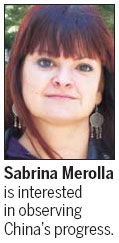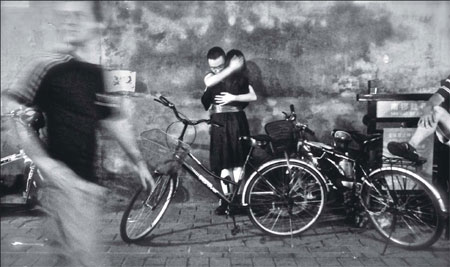In a snapshot
Updated: 2012-11-09 10:07
By Zhang Lei (China Daily)
|
||||||||
|
Sabrina Merolla's work aims to combine photography and anthropology - her blurred pictures add to the appeal. Provided to China Daily |
An Italian photographer finds that some of the blurriest visions are the sharpest
Sabrina Merolla is enthralled by the images that flit past her eyes every day in Beijing. Through her camera lens those seemingly transient scenes of everyday life take on a more permanent nature. Merolla, 35, from Italy, has been a photographer for 10 years, and she regards her love for taking such pictures not just as a release from the pace of modern life, but as an opportunity to reconnect with reality and the life within. Merolla has been keeping track of the daily sights and sounds of the Chinese world by using what she calls the snapshot style. "The trick of photography is to keep sights fresh," she says.

In June she held a small black-and-white photography exhibition at an Italian bar near the Drum Tower in Beijing. Her pictures are images of what many might have taken for granted, such as a grandmother and her grandson.
She says contrast is a key to her works. "What I like to observe daily in this country and any other country is contrast. Completely different kinds of life, attitude, and views confront me all the time. People you meet daily in the subway and the street have different behaviors. Some are really educated, polite, and some are not. What I like to find in my pictures is your own way of harmony, the kind of mixed differences."
Merolla believes there should be no distance between her snapshots and those who look at them, but her vision of reality can be somewhat blurred.
"I want my pictures to be more sensational. I don't want clear, refined ones, because reality to me is not that way, so I try every way to make it blur."
That method means there are some who do not appreciate her work. Some like a very clear attitude to reality, she says, but she sees life differently. "I think my method is greatly influenced by Taoism. Everything changes, but in some way everything can be put together and made into harmony, so I just put all these elements through my camera between yin and yang."
Last year she won a prize in a "Focus on China" photography competition organized by Creative Commons, a California-based non-profit group devoted to expanding the range of creative works available for others to legally use and share without charge.
The topic covered development and modernization in modern China, and the works of Merolla and 29 Chinese photographers were presented at the Inter Art Center & Gallery of 798 Art Zone in Beijing.
"Every place has a history behind it and every person has his own story," Merolla says. "My work is to resonate with what is hidden in them."
Merolla says she picks up scattered dramas and forms a narrative in her pictures.
One of her black-and-white photo series is called Roads, for which she traveled in China's urban and rural regions, looking at daily life and traditions in pursuit of personal spiritual release. She regards every picture as posing a question about modern reality, all the snapshots captured either on the street, outside windows, or in high-speed trains, and working like a silent movie, a dream-like recollection of her vision of the world.
"I use different filters in different shootings and sessions, and put them together. Sometimes I like to take pictures through glasses. Much of my photography is cinematic. In films when the camera moves, everything blurs, and I use the same method in my pictures.
"Sometimes when I take a picture of a profile, I ask the person to move his hand slowly, and give him time to move in slow motion. The slow timing is better for me to capture what I want."
Merolla is particularly fond of capturing how the elderly and youngsters live in contemporary China and how they see it. Several years living in China have equipped her with an acute awareness of the country's progress.
"Progress in western China is most evident. I've seen the Chinese trying to work out the equilibrium between cities and countryside. But there are still enormous tasks they must face, such as pollution and urbanization. But I am here because I want to see, not to judge. I am interested to see how it works."
She is now in a transition with her photographic style, she says, aiming to put photography and anthropology together. "If you live in a mega city like Beijing, when you go to rural China, you can feel the development there is 30 years behind, one of the reasons for the migrant waves in big cities. This is one part of my urban anthropology research."
Merolla first came to China in 2005 and was in a PhD program of Chinese contemporary cultural studies in Shanghai for three years. Over that time, the study of the overlay of Chinese cultural recognition and memory enabled her to concentrate on taking black and white pictures.
She was born and raised in Naples, where she obtained a master's degree in oriental cultures and languages in 2004. She says the talent she has developed is a combination of two ancient cultures that freed her from mediocrity.
She is happy to get feedback from Chinese people about her work, she says, their suggestions helping her explore future topics for her "memory shots".
"My Chinese viewers have said to me that they can see realistic visions of China in my pictures. As for the feedback, even I know the picture is not exactly a mirror. You have your own view, and I would like to share a kind of vision with the people inside my photo. They can understand, and they can share too. I would like them to feel something with my picture, to feel like at home."
zhanglei@chinadaily.com.cn
(China Daily 11/09/2012 page28)

 'Taken 2' grabs movie box office crown
'Taken 2' grabs movie box office crown
 Rihanna's 'Diamonds' tops UK pop chart
Rihanna's 'Diamonds' tops UK pop chart
 Fans get look at vintage Rolling Stones
Fans get look at vintage Rolling Stones
 Celebrities attend Power of Women event
Celebrities attend Power of Women event
 Ang Lee breaks 'every rule' to make unlikely new Life of Pi film
Ang Lee breaks 'every rule' to make unlikely new Life of Pi film
 Rihanna almost thrown out of nightclub
Rihanna almost thrown out of nightclub
 'Dark Knight' wins weekend box office
'Dark Knight' wins weekend box office
 'Total Recall' stars gather in Beverly Hills
'Total Recall' stars gather in Beverly Hills
Most Viewed
Editor's Picks

|

|

|

|

|

|
Today's Top News
Health new priority for quake zone
Xi meets US top military officer
Japan's boats driven out of Diaoyu
China mulls online shopping legislation
Bird flu death toll rises to 22
Putin appoints new ambassador to China
Japanese ships blocked from Diaoyu Islands
Inspired by Guan, more Chinese pick up golf
US Weekly

|

|







